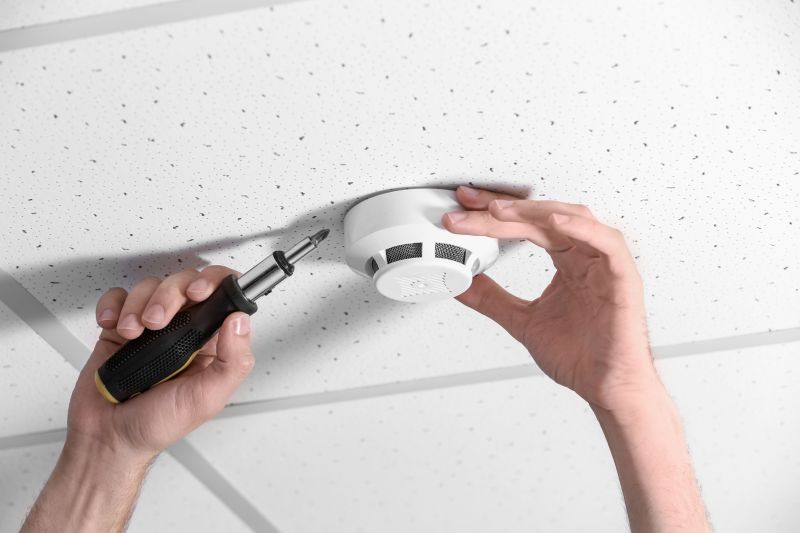Top Products For Smoke Alarm Installations To Ensure Safety
Explore essential tools and accessories that make installing smoke alarms easier, more reliable, and compliant with safety standards.
 Installing smoke alarms is a crucial step in ensuring safety within residential and commercial spaces. The process involves selecting appropriate devices, mounting them securely, and maintaining their functionality over time. There are various types of smoke alarms designed to suit different environments and user preferences, each with unique features and installation requirements. Proper placement and installation can significantly enhance the effectiveness of these devices in alerting occupants to potential fire hazards.
Installing smoke alarms is a crucial step in ensuring safety within residential and commercial spaces. The process involves selecting appropriate devices, mounting them securely, and maintaining their functionality over time. There are various types of smoke alarms designed to suit different environments and user preferences, each with unique features and installation requirements. Proper placement and installation can significantly enhance the effectiveness of these devices in alerting occupants to potential fire hazards.
Top Overall Option
Multi-Function Smoke Alarm with Interconnectivity
This versatile smoke alarm combines photoelectric and ionization sensing technologies to provide comprehensive detection capabilities. It features easy installation options, a loud alarm, and the ability to connect with multiple units for whole-home coverage. Its user-friendly interface includes test and hush buttons, making maintenance straightforward and ensuring reliable operation over time.
Types of Products For Smoke Alarm Installations
Wired Smoke Alarms
Hardwired units that connect directly to your home's electrical system, often with battery backup for continuous operation during power outages.
Wireless Smoke Alarms
Battery-powered or Wi-Fi enabled devices that can be easily installed without wiring, often capable of interconnection for whole-home alerts.
Combination Smoke and Carbon Monoxide Alarms
Devices that detect both smoke and carbon monoxide, providing dual safety functions in a single unit.
Photoelectric Smoke Alarms
Sensors that detect smoke particles using light sensors, typically less prone to false alarms caused by cooking fumes.
Ionization Smoke Alarms
Sensors that detect smoke particles through ionization, often more responsive to flaming fires.
Smart Smoke Alarms
Connected devices that integrate with smart home systems, allowing remote monitoring and alerts via mobile apps.
Battery-Operated Smoke Alarms
Standalone units powered solely by batteries, suitable for areas without wiring access.
Interconnected Smoke Alarms
Multiple units linked together so that when one detects smoke, all alarms sound simultaneously.
Ceiling-Mount Smoke Alarms
Designed for ceiling installation, these alarms are positioned to detect rising smoke effectively.
Wall-Mount Smoke Alarms
Installed on walls, typically at a recommended height for optimal smoke detection.
Popular Choices
Widely favored for their ease of installation and ability to connect multiple units for comprehensive coverage.
Popular for their remote monitoring features and integration with smart home ecosystems.
Chosen for their dual detection capabilities, providing added safety in residential settings.
Often selected for their reduced false alarms, especially in kitchens and bedrooms.
Preferred for quick installation and in locations without wiring access.
Commonly installed for optimal smoke detection in living areas and hallways.
Popular for their convenience in silencing false alarms without disabling the device.
Increasingly chosen for their ability to send alerts directly to smartphones and integrate with other smart devices.
Favored for ensuring consistent alerts throughout multi-room residences.
Selected for their strategic placement in areas where ceiling mounting isn't feasible.
When considering smoke alarm installations, it is important to evaluate the environment where they will be installed. Factors such as ceiling height, room size, and potential sources of false alarms should influence the choice of products. Some alarms are designed for specific areas like kitchens or garages, where false alarms are more common. Additionally, wired and wireless options provide different advantages in terms of installation flexibility and power sources.
Maintenance is another key aspect of smoke alarm safety. Regular testing, battery replacement, and cleaning are necessary to ensure continuous operation. Many modern devices include features such as hush buttons, interconnectivity, and smart home integration, which can enhance user convenience and safety oversight. Proper installation and ongoing maintenance help maximize the lifespan and reliability of smoke alarms, providing peace of mind for users.
Overall, selecting the right products for smoke alarm installation involves understanding your specific needs, the environment, and the features offered by different devices. A comprehensive approach to choosing and maintaining these safety devices can significantly contribute to a safer living or working space, helping to detect smoke early and alert occupants promptly.
Key Buying Considerations
- Compatibility with existing wiring or preference for wireless units
- Sensor type (photoelectric, ionization, or dual-sensor) based on fire detection needs
- Power source options including battery, hardwired, or smart connections
- Interconnectivity features for synchronized alarms across multiple units
- Ease of installation, especially for DIY projects
- Maintenance requirements such as battery replacement and regular testing
- Additional features like hush buttons, LED indicators, and smart alerts
- Size and mounting options suitable for intended installation locations
- Environmental considerations such as dust or humidity resistance
- Compliance with local safety standards and regulations
- Compatibility with smart home systems if remote monitoring is desired
- Price point relative to features and brand reputation
- Warranty and customer support options
- User reviews and ratings for real-world performance insights
- Availability of replacement parts and accessories
